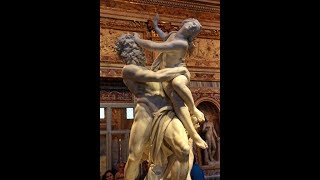The Rape of Proserpina (Italian: Ratto di Proserpina) is a large Baroque marble sculptural group by Italian artist Gian Lorenzo Bernini, executed between 1621 and 1622. Bernini was only 23 years old at its completion. It depicts the Abduction of Proserpina, where Proserpina is seized and taken to the underworld by the god Pluto.
As with many of Bernini’s early works, it was commissioned by Cardinal Scipione Borghese, possibly alongside a portrait of Scipione’s uncle Pope Paul V (who had died in 1621).
In Greek mythology, Persephone is the daughter of Zeus and Demeter and is the queen of the underworld. Homer describes her as the formidable, venerable majestic princess of the underworld, who carries into effect the curses of men upon the souls of the dead. Persephone was married to Hades, the god of the underworld. The myth of her abduction represents her function as the personification of vegetation, which shoots forth in spring and withdraws into the earth after harvest; hence, she is also associated with spring as well as the fertility of vegetation.
The story of her abduction by Hades against her will is traditionally referred to as the Rape of Persephone. It is mentioned briefly in Hesiod’s Theogony, and told in considerable detail in the Homeric Hymn to Demeter. Persephone used to live far away from the other gods, a goddess within Nature herself before the days of planting seeds and nurturing plants. In the Olympian telling, the gods Hermes and Apollo had wooed Persephone; but Demeter rejected all their gifts and hid her daughter away from the company of the Olympian gods. Zeus, it is said, permitted Hades, who was in love with the beautiful Persephone, to abduct her as her mother Demeter was not likely to allow her daughter to go down to Hades. Persephone was gathering flowers with the Oceanids along with Artemis and Athena—the Homeric Hymn says—in a field when Hades came to abduct her, bursting through a cleft in the earth. Demeter, when she found her daughter had disappeared, searched for her all over the earth with Hecate’s torches. In most versions she forbids the earth to produce, or she neglects the earth and in the depth of her despair she causes nothing to grow. Helios, the sun, who sees everything, eventually told Demeter what had happened and at length she discovered the place of her abode. Finally, Zeus, pressed by the cries of the hungry people and by the other deities who also heard their anguish, forced Hades to return Persephone.
Source Article from http://www.renegadetribune.com/the-rape-of-proserpina/
 RSS Feed
RSS Feed















 April 21st, 2018
April 21st, 2018  Awake Goy
Awake Goy 
 Posted in
Posted in  Tags:
Tags: 













